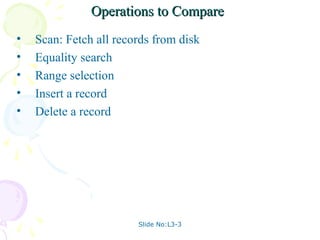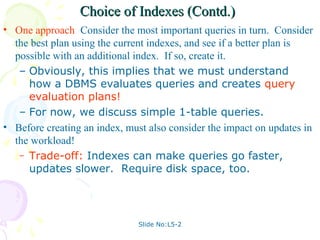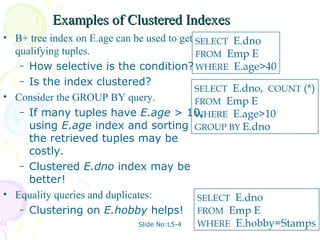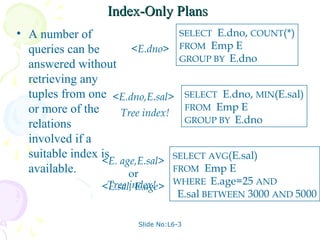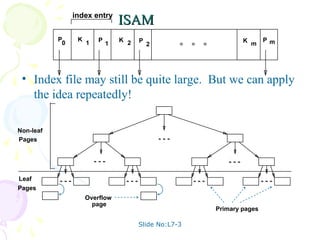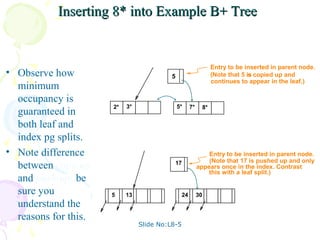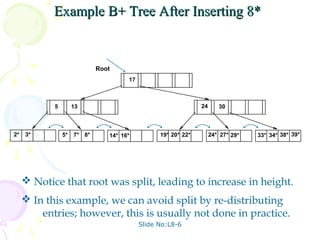Unit 08 dbms
- 1. DATABASE MANAGEMENT SYSTEMS MALLA REDDY ENGG. COLLEGE HYD II B. Tech CSE II Semester UNIT-VIII PPT SLIDES Text Books: (1) DBMS by Raghu Ramakrishnan (2) DBMS by Sudarshan and Korth
- 2. INDEX UNIT-8 PPT SLIDES S.NO Module as per Lecture PPT Session planner No Slide NO ------------------------------------------------------------------------------------------------- 1. Data on external storage & File organization and indexing L1 L1- 1 to L1- 4 2. Index data structures L2 L2- 1 to L2- 7 3. Comparison of file organizations L3 L3- 1 to L3- 5 4. Comparison of file organizations L4 L4- 1 to L4- 2 5. Indexes and performance tuning L5 L5- 1 to L5- 4 6. Indexes and performance tuning L6 L6- 1 to L6 -5 7. Intuition for tree indexes & ISAM L7 L7- 1 to L7- 7 8. B+ tree L8 L8- 1 to L8- 9
- 3. Data on External Storage • Disks: Can retrieve random page at fixed cost – But reading several consecutive pages is much cheaper than reading them in random order • Tapes: Can only read pages in sequence – Cheaper than disks; used for archival storage • File organization: Method of arranging a file of records on external storage. – Record id (rid) is sufficient to physically locate record – Indexes are data structures that allow us to find the record ids of records with given values in index search key fields • Architecture: Buffer manager stages pages from external storage to main memory buffer pool. File and index layers make calls to the buffer manager. Slide No:L1-1
- 4. Alternative File Organizations Many alternatives exist, each ideal for some situations, and not so good in others: – Heap (random order) files: Suitable when typical access is a file scan retrieving all records. – Sorted Files: Best if records must be retrieved in some order, or only a `range’ of records is needed. – Indexes: Data structures to organize records via trees or hashing. • Like sorted files, they speed up searches for a subset of records, based on values in certain (“search key”) fields • Updates are much faster than in sorted files. Slide No:L1-2
- 5. Index Classification • Primary vs. secondary: If search key contains primary key, then called primary index. – Unique index: Search key contains a candidate key. • Clustered vs. unclustered: If order of data records is the same as, or `close to’, order of data entries, then called clustered index. – Alternative 1 implies clustered; in practice, clustered also implies Alternative 1 (since sorted files are rare). – A file can be clustered on at most one search key. – Cost of retrieving data records through index varies greatly based on whether index is clustered or not! Slide No:L1-3
- 6. Clustered vs. Unclustered Index • Suppose that Alternative (2) is used for data entries, and that the data records are stored in a Heap file. – To build clustered index, first sort the Heap file (with some free space on each page for future inserts). – Overflow pages may be needed for inserts. (Thus, order of data recs is `close to’, but not identical to, the sort order.) Index entries direct search for data entries CLUSTERED UNCLUSTERED Data entries Data entries (Index File) (Data file) Data Records Data Records Slide No:L1-4
- 7. Indexes • An index on a file speeds up selections on the search key fields for the index. – Any subset of the fields of a relation can be the search key for an index on the relation. – Search key is not the same as key (minimal set of fields that uniquely identify a record in a relation). • An index contains a collection of data entries, and supports efficient retrieval of all data entries k* with a given key value k. – Given data entry k*, we can find record with key k in at most one disk I/O. (Details soon …) Slide No:L2-1
- 8. B+ Tree Indexes Non-leaf Pages Leaf Pages (Sorted by search key) Leaf pages contain data entries, and are chained (prev & next) Non-leaf pages have index entries; only used to direct searches: index entry P0 K 1 P1 K 2 P 2 K m Pm Slide No:L2-2
- 9. Example B+ Tree Root Note how data entries 17 in leaf level are sorted Entries <= 17 Entries > 17 5 13 27 30 2* 3* 5* 7* 8* 14* 16* 22* 24* 27* 29* 33* 34* 38* 39* • Find 28*? 29*? All > 15* and < 30* • Insert/delete: Find data entry in leaf, then change it. Need to adjust parent sometimes. – And change sometimes bubbles up the tree Slide No:L2-3
- 10. Hash-Based Indexes • Good for equality selections. • Index is a collection of buckets. – Bucket = primary page plus zero or more overflow pages. – Buckets contain data entries. • Hashing function h: h(r) = bucket in which (data entry for) record r belongs. h looks at the search key fields of r. – No need for “index entries” in this scheme. Slide No:L2-4
- 11. Alternatives for Data Entry k* in Index • In a data entry k* we can store: – Data record with key value k, or – <k, rid of data record with search key value k>, or – <k, list of rids of data records with search key k> • Choice of alternative for data entries is orthogonal to the indexing technique used to locate data entries with a given key value k. – Examples of indexing techniques: B+ trees, hash- based structures – Typically, index contains auxiliary information that directs searches to the desired data entries Slide No:L2-5
- 12. Alternatives for Data Entries (Contd.) • Alternative 1: – If this is used, index structure is a file organization for data records (instead of a Heap file or sorted file). – At most one index on a given collection of data records can use Alternative 1. (Otherwise, data records are duplicated, leading to redundant storage and potential inconsistency.) – If data records are very large, # of pages containing data entries is high. Implies size of auxiliary information in the index is also large, typically. Slide No:L2-6
- 13. Alternatives for Data Entries (Contd.) • Alternatives 2 and 3: – Data entries typically much smaller than data records. So, better than Alternative 1 with large data records, especially if search keys are small. (Portion of index structure used to direct search, which depends on size of data entries, is much smaller than with Alternative 1.) – Alternative 3 more compact than Alternative 2, but leads to variable sized data entries even if search keys are of fixed length. Slide No:L2-7
- 14. Cost Model for Our Analysis We ignore CPU costs, for simplicity: – B: The number of data pages – R: Number of records per page – D: (Average) time to read or write disk page – Measuring number of page I/O’s ignores gains of pre-fetching a sequence of pages; thus, even I/O cost is only approximated. – Average-case analysis; based on several simplistic assumptions. Slide No:L3-1
- 15. Comparing File Organizations • Heap files (random order; insert at eof) • Sorted files, sorted on <age, sal> • Clustered B+ tree file, Alternative (1), search key <age, sal> • Heap file with unclustered B + tree index on search key <age, sal> • Heap file with unclustered hash index on search key <age, sal> Slide No:L3-2
- 16. Operations to Compare • Scan: Fetch all records from disk • Equality search • Range selection • Insert a record • Delete a record Slide No:L3-3
- 17. Assumptions in Our Analysis • Heap Files: – Equality selection on key; exactly one match. • Sorted Files: – Files compacted after deletions. • Indexes: – Alt (2), (3): data entry size = 10% size of record – Hash: No overflow buckets. • 80% page occupancy => File size = 1.25 data size – Tree: 67% occupancy (this is typical). • Implies file size = 1.5 data size Slide No:L3-4
- 18. Assumptions (contd.) • Scans: – Leaf levels of a tree-index are chained. – Index data-entries plus actual file scanned for unclustered indexes. • Range searches: – We use tree indexes to restrict the set of data records fetched, but ignore hash indexes. Slide No:L3-5
- 19. Cost of Operations (a) Scan (b) Equality (c ) Range (d) Insert (e) Delete (1) Heap BD 0.5BD BD 2D Search +D (2) Sorted BD Dlog 2B D(log 2 B + Search Search # pgs with + BD +BD match recs) (3) 1.5BD Dlog F 1.5B D(log F 1.5B Search Search Clustered + # pgs w. +D +D match recs) (4) Unclust. BD(R+0.15) D(1 + D(log F 0.15B Search Search Tree index log F 0.15B) + # pgs w. + 2D + 2D match recs) (5) Unclust. BD(R+0.125) 2D BD Search Search Hash index + 2D + 2D Slide No:L4-1
- 20. Understanding the Workload • For each query in the workload: – Which relations does it access? – Which attributes are retrieved? – Which attributes are involved in selection/join conditions? How selective are these conditions likely to be? • For each update in the workload: – Which attributes are involved in selection/join conditions? How selective are these conditions likely to be? – The type of update (INSERT/DELETE/UPDATE), and the attributes that are affected. Slide No:L4-2
- 21. Choice of Indexes • What indexes should we create? – Which relations should have indexes? What field(s) should be the search key? Should we build several indexes? • For each index, what kind of an index should it be? – Clustered? Hash/tree? Slide No:L5-1
- 22. Choice of Indexes (Contd.) • One approach: Consider the most important queries in turn. Consider the best plan using the current indexes, and see if a better plan is possible with an additional index. If so, create it. – Obviously, this implies that we must understand how a DBMS evaluates queries and creates query evaluation plans! – For now, we discuss simple 1-table queries. • Before creating an index, must also consider the impact on updates in the workload! – Trade-off: Indexes can make queries go faster, updates slower. Require disk space, too. Slide No:L5-2
- 23. Index Selection Guidelines • Attributes in WHERE clause are candidates for index keys. – Exact match condition suggests hash index. – Range query suggests tree index. • Clustering is especially useful for range queries; can also help on equality queries if there are many duplicates. • Multi-attribute search keys should be considered when a WHERE clause contains several conditions. – Order of attributes is important for range queries. – Such indexes can sometimes enable index-only strategies for important queries. • For index-only strategies, clustering is not important! Slide No:L5-3
- 24. Examples of Clustered Indexes • B+ tree index on E.age can be used to get SELECT E.dno qualifying tuples. FROM Emp E – How selective is the condition? WHERE E.age>40 – Is the index clustered? SELECT E.dno, COUNT (*) • Consider the GROUP BY query. FROM Emp E – If many tuples have E.age > 10, WHERE E.age>10 using E.age index and sorting GROUP BY E.dno the retrieved tuples may be costly. – Clustered E.dno index may be better! • Equality queries and duplicates: SELECT E.dno – Clustering on E.hobby helps! FROM Emp E Slide No:L5-4 WHERE E.hobby=Stamps
- 25. Indexes with Composite Search Keys • Composite Search Keys: Search on a Examples of composite key combination of fields. indexes using lexicographic order. – Equality query: Every field value is equal to a constant value. E.g. wrt <sal,age> index: • age=20 and sal =75 11,80 11 12,10 12 – Range query: Some field name age sal 12,20 12 value is not a constant. 13,75 bob 12 10 13 E.g.: <age, sal> cal 11 80 <age> • age =20; or age=20 joe 12 20 and sal > 10 10,12 sue 13 75 10 20,12 20 • Data entries in index sorted by Data records 75,13 sorted by name 75 search key to support range queries. 80,11 80 – Lexicographic order, or <sal, age> <sal> – Spatial order. Data entries in index Data entries sorted by <sal,age> sorted by <sal> Slide No:L6-1
- 26. Composite Search Keys • To retrieve Emp records with age=30 AND sal=4000, an index on <age,sal> would be better than an index on age or an index on sal. – Choice of index key orthogonal to clustering etc. • If condition is: 20<age<30 AND 3000<sal<5000: – Clustered tree index on <age,sal> or <sal,age> is best. • If condition is: age=30 AND 3000<sal<5000: – Clustered <age,sal> index much better than <sal,age> index! • Composite indexes are larger, updated more often. Slide No:L6-2
- 27. Index-Only Plans • A number of SELECT E.dno, COUNT(*) queries can be <E.dno> FROM Emp E GROUP BY E.dno answered without retrieving any tuples from one <E.dno,E.sal> SELECT E.dno, MIN(E.sal) or more of the FROM Emp E Tree index! relations GROUP BY E.dno involved if a suitable index is <E. age,E.sal> SELECT AVG(E.sal) available. or FROM Emp E <E.sal, E.age> WHERE E.age=25 AND Tree index! E.sal BETWEEN 3000 AND 5000 Slide No:L6-3
- 28. Summary • Many alternative file organizations exist, each appropriate in some situation. • If selection queries are frequent, sorting the file or building an index is important. – Hash-based indexes only good for equality search. – Sorted files and tree-based indexes best for range search; also good for equality search. (Files rarely kept sorted in practice; B+ tree index is better.) • Index is a collection of data entries plus a way to quickly find entries with given key values. Slide No:L6-4
- 29. Summary (Contd.) • Data entries can be actual data records, <key, rid> pairs, or <key, rid-list> pairs. – Choice orthogonal to indexing technique used to locate data entries with a given key value. • Can have several indexes on a given file of data records, each with a different search key. • Indexes can be classified as clustered vs. unclustered, primary vs. secondary, and dense vs. sparse. Differences have important consequences for utility/performance. Slide No:L6-5
- 30. Introduction • As for any index, 3 alternatives for data entries k*: – Data record with key value k – <k, rid of data record with search key value k> – <k, list of rids of data records with search key k> • Choice is orthogonal to the indexing technique used to locate data entries k*. • Tree-structured indexing techniques support both range searches and equality searches. • ISAM: static structure; B+ tree: dynamic, adjusts gracefully under inserts and deletes. Slide No:L7-1
- 31. Range Searches • ``Find all students with gpa > 3.0’’ – If data is in sorted file, do binary search to find first such student, then scan to find others. – Cost of binary search can be quite high. • Simple idea: Create an `index’ file. k1 k2 kN Index File Page 1 Page 2 Page 3 Page N Data File Slide No:L7-2
- 32. index entry ISAM P K P K 2 P K m Pm 0 1 1 2 • Index file may still be quite large. But we can apply the idea repeatedly! Non-leaf Pages Leaf Pages Overflow page Primary pages Slide No:L7-3
- 33. Comments on ISAM Data Pages • File creation: Leaf (data) pages allocated sequentially, sorted by search key; then index pages allocated, then space for overflow pages. Index Pages • Index entries: <search key value, page id>; they `direct’ search for data entries, which are in leaf pages. Overflow pages • Search: Start at root; use key comparisons to go to leaf. Cost log F N ; F = # entries/index pg, N = # leaf pgs ∝ • Insert: Find leaf data entry belongs to, and put it there. • Delete: Find and remove from leaf; if empty overflow page, de-allocate. Slide No:L7-4
- 34. Example ISAM Tree • Each node can hold 2 entries; no need for `next-leaf- page’ pointers. (Why?) Root 40 20 33 51 63 10* 15* 20* 27* 33* 37* 40* 46* 51* 55* 63* 97* Slide No:L7-5
- 35. After Inserting 23*, 48*, 41*, 42* ... Root Index 40 Pages 20 33 51 63 Primary Leaf 10* 15* 20* 27* 33* 37* 40* 46* 51* 55* 63* 97* Pages Overflow 23* 48* 41* Pages 42* Slide No:L7-6
- 36. ... Then Deleting 42*, 51*, 97* Root 40 20 33 51 63 10* 15* 20* 27* 33* 37* 40* 46* 55* 63* 23* 48* 41* Slide No:L7-7
- 37. B+ Tree: Most Widely Used Index • Insert/delete at log F N cost; keep tree height-balanced. (F = fanout, N = # leaf pages) • Minimum 50% occupancy (except for root). Each node contains d <= m <= 2d entries. The parameter d is called the order of the tree. • Supports equality and range-searches efficiently. Index Entries (Direct search) Data Entries ("Sequence set") Slide No:L8-1
- 38. Example B+ Tree • Search begins at root, and key comparisons direct it to a leaf (as in ISAM). • Search for 5*, 15*, all data entries >= 24* ... Root 13 17 24 30 2* 3* 5* 7* 14* 16* 19* 20* 22* 24* 27* 29* 33* 34* 38* 39* Slide No:L8-2
- 39. B+ Trees in Practice • Typical order: 100. Typical fill-factor: 67%. – average fanout = 133 • Typical capacities: – Height 4: 1334 = 312,900,700 records – Height 3: 1333 = 2,352,637 records • Can often hold top levels in buffer pool: – Level 1 = 1 page = 8 Kbytes – Level 2 = 133 pages = 1 Mbyte – Level 3 = 17,689 pages = 133 MBytes Slide No:L8-3
- 40. Inserting a Data Entry into a B+ Tree • Find correct leaf L. • Put data entry onto L. – If L has enough space, done! – Else, must split L (into L and a new node L2) • Redistribute entries evenly, copy up middle key. • Insert index entry pointing to L2 into parent of L. • This can happen recursively – To split index node, redistribute entries evenly, but push up middle key. (Contrast with leaf splits.) • Splits “grow” tree; root split increases height. – Tree growth: gets wider or one level taller at top. Slide No:L8-4
- 41. Inserting 8* into Example B+ Tree Entry to be inserted in parent node. • Observe how 5 (Note that 5 is copied up and s continues to appear in the leaf.) minimum occupancy is 2* 3* 5* 7* 8* guaranteed in both leaf and index pg splits. • Note difference Entry to be inserted in parent node. (Note that 17 is pushed up and only between copy-up 17 appears once in the index. Contrast this with a leaf split.) and push-up; be sure you 5 13 24 30 understand the reasons for this. Slide No:L8-5
- 42. Example B+ Tree After Inserting 8* Root 17 5 13 24 30 2* 3* 5* 7* 8* 14* 16* 19* 20* 22* 24* 27* 29* 33* 34* 38* 39* Notice that root was split, leading to increase in height. In this example, we can avoid split by re-distributing entries; however, this is usually not done in practice. Slide No:L8-6
- 43. Deleting a Data Entry from a B+ Tree • Start at root, find leaf L where entry belongs. • Remove the entry. – If L is at least half-full, done! – If L has only d-1 entries, • Try to re-distribute, borrowing from sibling (adjacent node with same parent as L). • If re-distribution fails, merge L and sibling. • If merge occurred, must delete entry (pointing to L or sibling) from parent of L. • Merge could propagate to root, decreasing height. Slide No:L8-7
- 44. Example Tree After (Inserting 8*, Then) Deleting 19* and 20* ... Root 17 5 13 27 30 2* 3* 5* 7* 8* 14* 16* 22* 24* 27* 29* 33* 34* 38* 39* • Deleting 19* is easy. • Deleting 20* is done with re-distribution. Notice how middle key is copied up. Slide No:L8-8
- 45. ... And Then Deleting 24* • Must merge. 30 • Observe `toss’ of index entry (on right), and 22* 27* 38* 39* 29* 33* 34* `pull down’ of index entry (below). Root 5 13 17 30 2* 3* 5* 7* 8* 14* 16* 22* 27* 29* 33* 34* 38* 39* Slide No:L8-9















